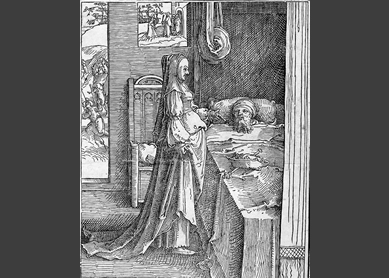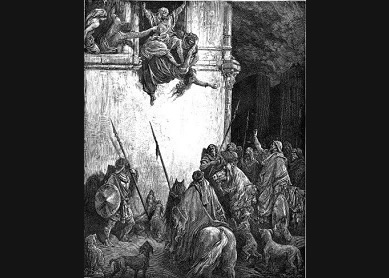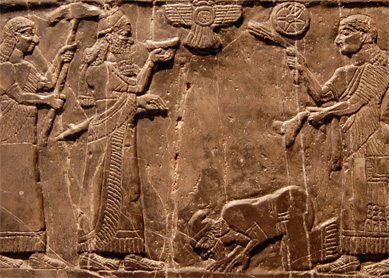Ahab was the son and successor of Omri. According to the Bible, he was one of Israel’s worst kings. The Bible presents him as the seventh king of Israel since the beginning of the divided monarchy following Solomon’s death.
Who Was the Historical Ahab?
Ahab was a real person who reigned over the northern kingdom of Israel from 871-852 B.C.E. The Assyrian king Shalmaneser III indicates that he defeated Ahab and eleven other kings in the Battle of Qarqar. Ahab’s father Omri appears referenced in the Moabite Mesha Stele. In terms of the Bible, the stories about the reign of Ahab are part of a collection of traditions concerning the prophet Elijah. These traditions circulated in prophetic groups that opposed the royal house of Omri. Little else is known about Ahab beyond what appears in the Hebrew Bible. This presents historians with a significant challenge.
In the books of Kings, the Bible portrays the story of the kingdom of Israel through the eyes of Judean writers. For centuries, the kingdom of Judah looked upon the more powerful, wealthier kingdom of Israel with fear and jealousy. These writers therefore depict Israel and her kings as evil. They serve as a warning against angering the Judean god, Yahweh. As a result, scholars who wish to achieve a less biased understanding of Israelite kings such as Ahab must adopt a historical-critical approach to the text that combines careful linguistic and literary analysis with archeological evidence.
What Role Did Ahab Play in the Biblical Story of Israel’s Past?
Ahab’s story appears in 1Kgs 16:29 through1Kgs 22:40. This material has been placed into a collection known as the Deuteronomistic History (Joshua, Judges, Samuel, Kings). This was a massive literary work, unparalleled in terms of scale by anything yet uncovered from the ancient Near East. Since most Judeans were no doubt illiterate and could not afford to own copies of this work, the history was probably produced for the royal court. Though updated and edited after the exile, it was most likely created to instruct future rulers on proper governance.
The story of Ahab would have been especially helpful for this agenda. He appears as a king who listened to the counsel of his foreign wife, Jezebel, daughter of the king of Tyre. According to the Bible, the two worked together to spread idol worship of Baal and fought against the prophets of Yahweh, including Elijah. According to the Deuteronomistic History, Ahab had five major conflicts with Yahweh’s prophets. These encounters appear in 1Kgs 17-18, 1Kgs 20:22; 1Kgs 20:34-43; 1Kgs 21:1-27; and 1Kgs 22.
The stories of Ahab’s conflict with these prophets provide a helpful illustration of the traditional role prophets fulfilled in ancient Israel and Judah. Prophets provided the checks and balance system for the monarchy, making sure that the king and his people behaved in ways that would appease their god. According to 1Kgs 22, the prophet Micaiah declared that Yahweh used Ahab’s prophets to trick him into going to battle at Ramoth-gilead so that Ahab would die. Hoping to avoid Micaiah’s prophecy, Ahab disguised himself, but fell mortally wounded by a random arrow. In accordance with Elijah’s earlier prophecy (1Kgs 22:19), dogs lapped up his blood, and whores bathed in it (v. 38; though the Greek Septuagint adds the detail that unclean pigs licked up his blood also).
This account was originally composed in the northern kingdom of Israel. It was probably taken to Judah by Israelite scribes fleeing the Assyrian conquest in 721 B.C.E. The story was then adopted and modified to match the agenda of the Deuteronomistic History, instructing Judean monarchs to avoid Ahab’s fate by remaining leery of foreign women and worshiping Yahweh in accordance with the standards of Deuteronomy. Ahab was a real, historical figure, but his story comes to us through a biased lens. If given the chance, he would have no doubt told his own story quite differently.
Perhaps with a goal of unifying his kingdom, Ahab embraced policies of compromise with traditional forms of Canaanite worship. Under his reign, the Canaanite cult of Baal attained equal status with the worship of Yahweh. According to 1Kgs 16:31-33, Ahab erected a temple in Samaria to Baal with a Baal altar and an image of the female goddess Asherah. As a result of these actions, the Bible states that Ahab did more evil in the sight of the LORD “than all who were before him” (1Kgs 16:30). Yet Ahab gave his sons the names Ahaziah and Jehoram, both of which contain the root of Yahweh’s name. This suggests that despite the Bible’s portrayal, Ahab maintained an attachment to the traditional god of Israel.




